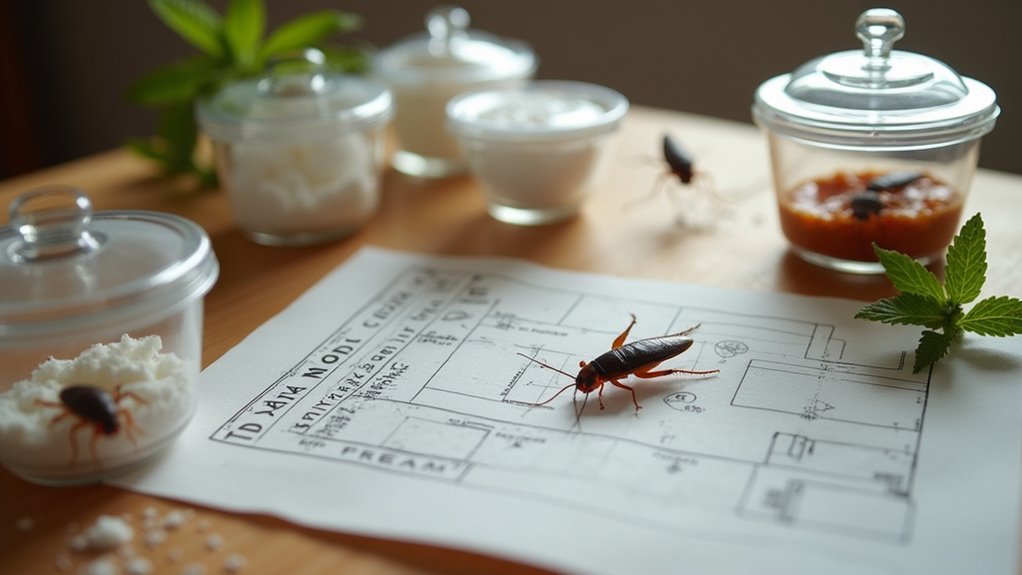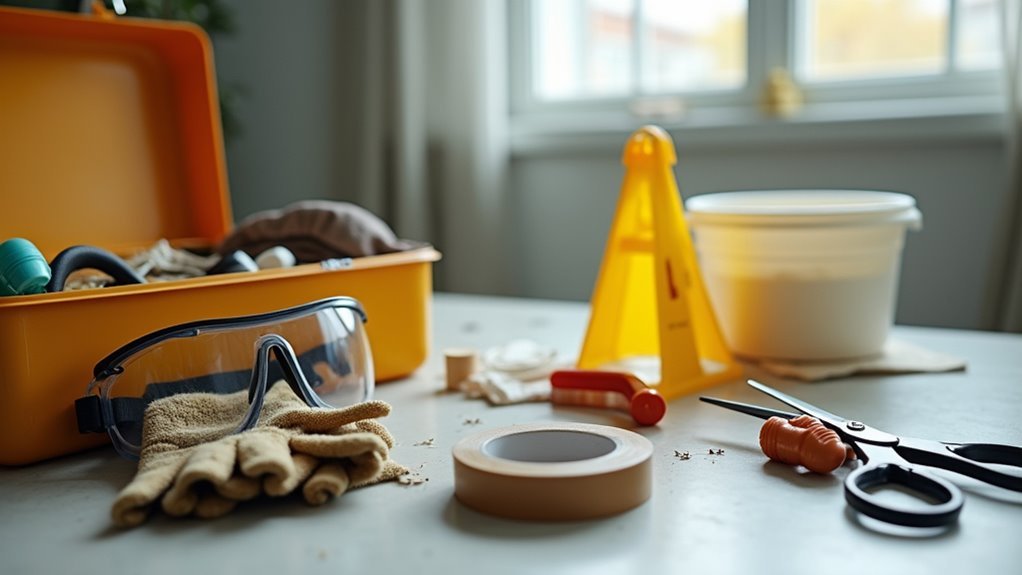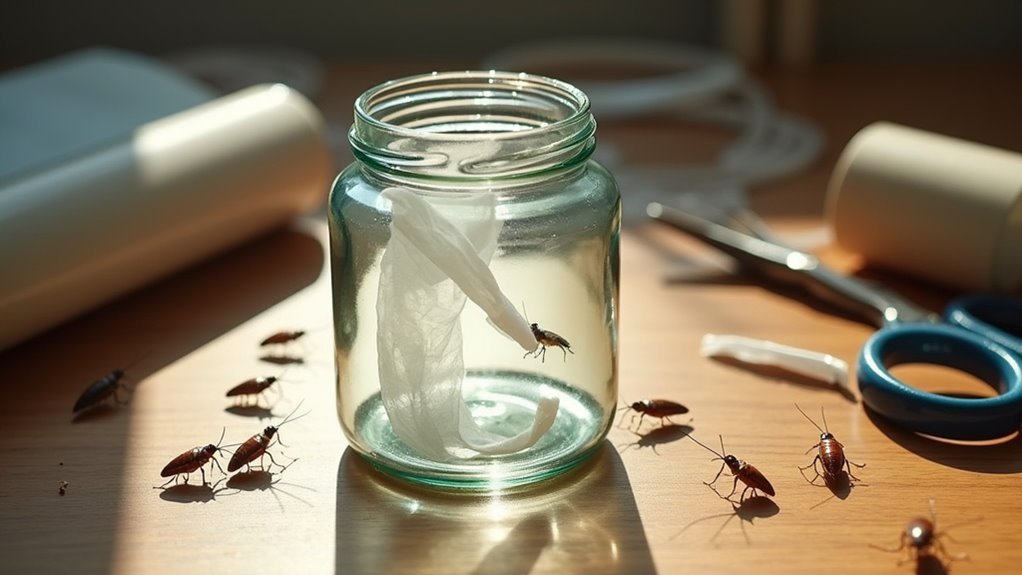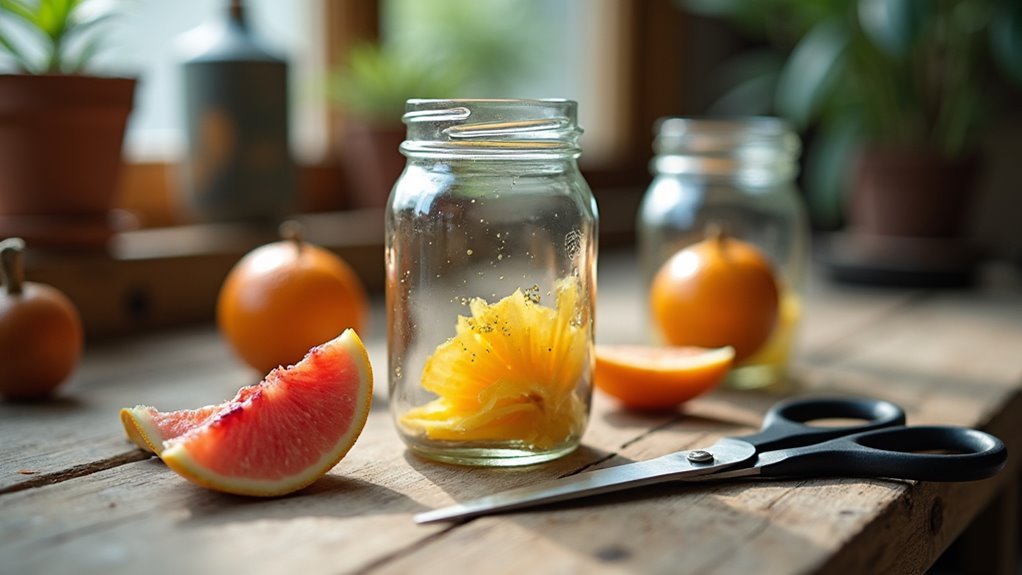You can build effective cockroach traps using common household materials like mason jars and petroleum jelly. Start by coating a quart-size jar’s interior with petroleum jelly, then place sweet bait like sugar or peanut butter at the bottom. Alternatively, create duct tape traps by placing sticky tape face-up in high-traffic areas with bait in the center. These homemade solutions cost 75% less than store-bought options while offering superior customization and safety for your family.
Why Homemade Cockroach Traps Work Better Than Store-Bought Options

While commercial cockroach traps promise quick results, you’ll find that homemade alternatives often outperform them in both effectiveness and value.
Creating your own homemade cockroach trap costs considerably less than purchasing store-bought versions, using common household materials you already have available.
Building effective cockroach traps from everyday items like jars, tape, and bait saves money while delivering superior results.
You can customize DIY traps with specific baits that target your local cockroach species, making them more effective than generic commercial options.
A homemade cockroach trap also serves as a non-toxic alternative, keeping your family and pets safer from harmful chemicals.
This affordable option gives you complete control over placement and baiting strategies.
You can target specific infestation areas while using reliable mechanics like petroleum jelly barriers or duct tape surfaces that prevent escapes better than many commercial designs.
Essential Materials and Tools for Building Your Trap
You’ll need just a few basic components to create an effective cockroach trap at home.
Your essential materials include glass jars or plastic containers, petroleum jelly for creating slippery surfaces, and attractive baits like sugar, peanut butter, or other sweet-smelling foods.
Don’t forget safety equipment such as gloves when handling potentially harmful ingredients like boric acid, along with simple tools like mixing bowls and popsicle sticks for preparation.
Basic Trap Components
Although homemade cockroach traps require just a few simple materials, selecting the right components makes the difference between success and failure.
You’ll need a quart-size mason jar as your primary container—its narrow neck prevents escape while allowing easy cockroach entry. Coat the jar’s interior with petroleum jelly to create a slippery surface that trapped insects can’t climb. For bait, use sweet or oily foods that attract your targets effectively.
Consider adding duct tape for alternative sticky traps by placing it sticky-side up in high-traffic areas.
Mix baking soda with sugar for enhanced effectiveness—this combination attracts cockroaches while delivering lethal results when ingested.
These basic components work together to address your cockroach infestation efficiently and affordably.
Safety Equipment Needed
Protection becomes your first priority when assembling cockroach traps, especially since you’ll handle potentially irritating substances. Essential safety equipment safeguards you from harmful chemicals like boric acid and petroleum jelly during preparation.
| Safety Equipment | Purpose |
|---|---|
| Gloves | Protect hands from irritants and chemicals |
| Dust Mask | Prevent inhalation of fine particles |
| Safety Goggles | Shield eyes from splashes and contact |
You’ll need gloves to protect your hands from boric acid and other materials. A dust mask prevents inhaling particles when mixing dry ingredients like baking soda. Safety goggles guard against accidental splashes or chemical contact with your eyes.
Store all materials away from children and pets to prevent accidental ingestion. Handle glass jars carefully to avoid cuts from broken pieces during trap assembly.
Safety Precautions Before Starting Your DIY Project

Before diving into your cockroach trap construction, taking proper safety measures will protect both you and your household from potential hazards.
These safety precautions are essential for a successful DIY project.
Always wear gloves and a dust mask when handling boric acid or other toxic materials to prevent skin irritation and inhalation risks.
Set up your workspace in a well-ventilated area to minimize exposure to harmful fumes or dust particles.
Store all materials, particularly bait and toxic substances, in secure locations away from children and pets to prevent accidental ingestion.
Read packaging instructions thoroughly before beginning your project to understand proper handling procedures.
Clean spills immediately and dispose of waste materials responsibly.
Keep your workspace organized and maintain proper ventilation throughout the entire construction process.
Duct Tape Trap Method: Simple and Effective Design
You’ll find the duct tape trap method requires minimal materials while delivering impressive results against cockroaches.
The setup involves placing fresh, sticky duct tape face-up in high-traffic areas where you’ve spotted these pests.
We’ll examine the essential materials you need and explore strategic placement techniques that maximize your trap’s effectiveness.
Materials and Setup
Creating an effective duct tape cockroach trap requires just two essential materials: fresh duct tape and attractive bait.
You’ll find this method incredibly straightforward and budget-friendly since it uses common household items.
Here’s what you’ll need for setup:
- Fresh duct tape – Verify the adhesive remains strong and sticky for maximum trapping effectiveness
- Sweet or oily bait – Small food pieces like bread crumbs, sugar, or peanut butter work excellently to lure cockroaches
- Strategic placement location – Choose high-traffic areas where you’ve spotted cockroach activity
Place the duct tape sticky-side up in these areas, position your bait in the center, and tuck the edges under to secure the trap.
This chemical-free approach offers a safe, cost-effective solution for cockroach control.
Placement and Effectiveness
Since cockroaches follow predictable movement patterns, positioning your duct tape traps along their common pathways dramatically increases capture rates.
Focus placement near water sources, behind appliances, under sinks, and along baseboards where cockroaches typically travel at night. Dark corners and areas with food debris also provide ideal trap locations.
The effectiveness of your traps depends on strategic positioning and regular maintenance.
Check your traps daily and replace them when they’re covered with debris or lose stickiness. Fresh bait every few days maintains attraction power.
Keep traps away from pets and children to prevent accidental contact with the adhesive.
Place them in areas your family doesn’t frequently access but cockroaches do.
This simple method provides immediate feedback about infestation severity while actively reducing cockroach populations.
Glass Jar Trap Construction: The Slippery Slope Technique

The glass jar trap represents one of the most effective DIY methods for capturing cockroaches without using chemical pesticides.
You’ll need a quart-size jar with a narrow neck to minimize escape opportunities. The petroleum jelly coating creates a slippery barrier that’s virtually impossible for cockroaches to climb.
Here’s your construction process:
- Prepare the jar – Coat interior walls thoroughly with petroleum jelly, ensuring complete coverage.
- Add bait – Place overripe fruit or beer-soaked bread at the bottom to attract cockroaches.
- Secure placement – Use sticky tape around the jar’s base to prevent tipping in high-traffic areas.
Position your trap in dark corners, kitchens, or near compost heaps where cockroach activity occurs.
Check daily and eliminate captured pests with boiling water before disposal.
Wine Bottle Trap Assembly: Attracting and Containing Roaches
You’ll transform an empty wine bottle into an effective cockroach trap by preparing the right bait and creating an inescapable interior surface.
Start by adding a few teaspoons of dry red wine mixed with sugar to attract roaches. Then coat the bottle’s neck with petroleum jelly to prevent their escape.
Strategic placement in dark corners and near roach activity areas will maximize your trap’s success rate.
Wine Bottle Preparation
When preparing your wine bottle trap, start with a tall, narrow-mouthed bottle and leave several teaspoons of dry red wine inside along with a quarter teaspoon of sugar to create an irresistible lure for cockroaches.
The sugar enhances the wine’s natural attraction, making it nearly impossible for roaches to resist.
Follow these essential preparation steps:
- Create the slippery surface – Smear cooking oil or petroleum jelly around the inside neck of the bottle to prevent escape once roaches enter.
- Establish a scent trail – Spill a few drops of wine leading toward the bottle opening to attract cockroaches from greater distances.
- Position strategically – Place your wine bottle trap in dark corners or near compost areas where cockroaches commonly gather.
Bait and Attraction
Once your bottle is properly prepared, focus on maximizing the trap’s effectiveness through strategic bait and attraction techniques.
Pour a few teaspoons of wine into your bottle, as the sweet aroma naturally draws cockroaches. For enhanced results, add a quarter teaspoon of sugar to dry red wine, creating an irresistible lure that’s more potent than sugar and water alone.
Coat the bottle’s inner neck with petroleum jelly or cooking oil, forming a slippery barrier that prevents escape once roaches enter.
Position your trap in dark corners or near compost heaps where cockroaches congregate. Monitor the trap overnight to evaluate its performance.
This effective way to control cockroach populations requires minimal investment while delivering reliable results when properly executed.
Trap Placement Strategy
Strategic placement determines your wine bottle trap’s success rate, so target the three primary areas where cockroaches naturally gather.
Your trap placement strategy should focus on locations where roaches feel secure and find food sources.
Position your traps in these common areas that naturally attract cockroaches:
- Dark corners and crevices – Place traps along baseboards, behind appliances, and in pantry corners where roaches hide during daylight hours.
- Near compost heaps and garbage – Set traps close to organic waste areas, both indoors and outdoors, where food odors draw roaches.
- Moisture-rich zones – Target areas around sinks, pipes, and humid spaces like basements where roaches seek water sources.
Leave traps undisturbed for at least one night, then monitor effectiveness over several days to optimize placement locations.
Boric Acid Bait Recipe for Enhanced Trap Performance
Creating an effective boric acid bait requires just three simple ingredients that transform your homemade trap into a powerful cockroach elimination tool.
Mix equal parts boric acid powder with sugar or honey to create an irresistible sweet attractant. Add a small amount of flour to bind the mixture while providing additional food appeal.
This deadly combination works because boric acid disrupts cockroaches’ digestive systems and causes fatal dehydration when they groom themselves after contact.
Place your bait in areas where cockroaches travel frequently—behind appliances, dark corners, and crevices. Keep food in sealed containers to force roaches toward your bait.
Refresh the mixture every few days to maintain its effectiveness and continue attracting new cockroaches to your trap.
Strategic Placement Locations for Maximum Effectiveness
Having prepared your boric acid bait mixture, you’ll need to position your traps where cockroaches naturally travel and congregate.
Strategic placement is essential for maximizing your trap’s effectiveness and eliminating these persistent pests.
Strategic trap placement directly determines your success rate in completely eliminating cockroach infestations from your home.
Focus on these key locations for best results:
- Kitchen zones – Place traps under sinks, behind appliances, and along countertops where cockroaches search for food and water.
- Dark hiding spots – Target corners, crevices, and areas near plumbing pipes where cockroaches hide during daylight hours.
- Food source areas – Position traps near garbage cans and pet feeding stations to intercept hungry roaches.
Deploy multiple traps across high-traffic areas to cover maximum ground.
Check and replace them every few days, monitoring which locations yield the most captures to refine your placement strategy.
Monitoring Your Traps and Tracking Results
Once your traps are in position, you’ll need to establish a consistent monitoring routine to gauge their performance and track your progress against the cockroach population.
Check your traps every 24 hours to count captured roaches and assess infestation severity. Keep a detailed log documenting catches in each trap, noting which types and bait work best in your specific environment.
Replace bait every few days since stale attractants reduce effectiveness. If certain traps aren’t performing well, relocate them to areas showing higher roach activity.
After several weeks of monitoring, analyze your data trends. If catches remain consistently high, you’ll need additional control methods.
This systematic tracking approach helps you optimize trap placement and bait selection while measuring your success.
Proper Disposal Methods for Captured Cockroaches
When your traps have successfully captured cockroaches, you’ll need to dispose of them safely and hygienically to prevent contamination and avoid attracting other pests.
Here are the proper disposal methods for captured cockroaches:
Proper cockroach disposal requires immediate killing with boiling water, responsible waste removal, and thorough sanitization to prevent contamination.
- Kill and sanitize: Pour boiling water directly into the trap to kill cockroaches instantly and guarantee proper sanitation. This eliminates any remaining life and reduces health risks.
- Dispose responsibly: Pour the hot water containing deceased cockroaches into your garden, compost heap, or toilet. Alternatively, seal dead cockroaches in plastic bags before throwing them in trash to prevent pest attraction.
- Clean thoroughly: Wear gloves when handling trapped cockroaches to maintain hygiene.
After disposal, clean and sanitize your trap completely to prevent odors and maintain its effectiveness for future captures.
Maintenance Schedule and Bait Replacement Guidelines
While your homemade cockroach trap represents an excellent first step in pest control, its long-term success depends entirely on consistent maintenance and timely bait replacement.
Check traps daily to monitor cockroach activity and reposition them based on catch rates. Replace bait every 3-5 days to maintain attractiveness, as roaches lose interest in stale bait over time.
| Maintenance Task | Frequency |
|---|---|
| Check traps and monitor activity | Daily |
| Replace bait in homemade traps | Every 3-5 days |
| Clean debris and dead roaches | Weekly |
| Reapply petroleum jelly/adhesive | Weekly |
Clean traps weekly, removing debris that could deter new catches. Reapply sticky substances to maintain adhesive properties. If trap effectiveness decreases considerably or you’re catching nothing after a week, relocate traps or try different bait options.
Scaling Up Your Trap Network for Severe Infestations
If you’re dealing with a severe cockroach infestation, you’ll need to dramatically expand your trapping strategy beyond a few scattered units. Your trap network must cover every potential cockroach pathway and gathering spot throughout your home.
Focus on these critical deployment strategies:
- Target high-traffic areas like kitchens, bathrooms, and dark corners where cockroaches congregate most frequently.
- Diversify your approach by combining duct tape, jar traps, and baking soda traps to maximize capture rates.
- Install traps at multiple levels – under appliances, behind furniture, and along walls where cockroaches travel.
Monitor your expanded network regularly and refresh bait as needed to maintain effectiveness.
Rotate trap types every few weeks since cockroaches can become wary of familiar setups, ensuring your pest control strategy remains robust.
Frequently Asked Questions
How Long Does It Take to See Results From Homemade Cockroach Traps?
You’ll typically notice cockroaches getting trapped within 24-48 hours if they’re actively foraging in your area. However, it might take up to a week to see significant results depending on infestation severity.
Can These DIY Traps Work for Other Types of Pests Besides Cockroaches?
You can adapt these traps for ants, silverfish, and beetles by changing baits. Sweet baits attract ants, while protein-based ones work for silverfish. However, they won’t effectively catch flying insects like flies or mosquitoes.
Are Homemade Cockroach Traps Safe to Use Around Pets and Children?
You’ll find homemade cockroach traps are generally safer than commercial pesticides around pets and children. However, you should still place them in areas where curious hands and paws can’t reach them easily.
What Should I Do if the Traps Aren’t Catching Any Roaches?
You should relocate your traps to areas with roach activity signs like droppings or grease marks. Try switching baits to something sweeter or greasier, and make certain you’re placing traps along walls where roaches travel.
How Do I Know if My Cockroach Problem Requires Professional Pest Control?
You’ll need professional pest control if you’re seeing roaches during daytime, finding egg cases frequently, noticing strong musty odors, or if DIY methods haven’t reduced the population after several weeks.
In Summary
You’ve now got the knowledge to build effective cockroach traps that’ll outperform expensive store-bought alternatives. Remember to check your traps daily, replace bait weekly, and dispose of captured roaches safely. If you’re dealing with severe infestations, don’t hesitate to scale up your trap network. With consistent monitoring and maintenance, you’ll greatly reduce your cockroach population while saving money. These DIY solutions won’t just catch roaches—they’ll give you control over your pest problem.





Leave a Reply